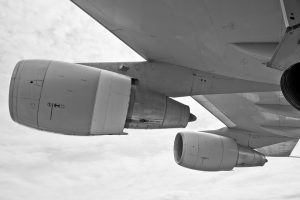 All combustion engines generate heat when running — and airplane engines are no exception. They work by igniting fuel and air in a combustion chamber. As these substances burn, heat is generated.
All combustion engines generate heat when running — and airplane engines are no exception. They work by igniting fuel and air in a combustion chamber. As these substances burn, heat is generated.
While airplane engines can withstand some heat, too much heat may result in damage. Excessive heat can warp engine surfaces, create cracks, vaporize oil and cause other forms of severe damage. To prevent this from happening, airplane engines must be cooled.
The Basics of Airplane Engine Cooling
Most airplanes feature air-cooled engines. In other words, they leverage the air traveling over the airplane’s frame to cool their engines. Air-cooled engines are designed with cooling fins. They are small and thin pieces of metal that protrude from the engine heads and barrels.
Cooling fins work by transferring heat from the engines to the exterior of the airplane. They’ll absorb heat from the engines with which they are used. Heat will transfer from the engines to the cooling fins. And because the cooling fins are located on the exterior of the airplane, heat will safely dissipate while subsequently protecting the engines from damage.
Automobiles, on the other hand, typically feature a liquid-cooled engine. Cars, trucks, SUVs and other automobiles with combustion engines use liquid to protect against excessive heat. Known as coolant, this liquid typically consists of a 50:50 mixture of antifreeze and distilled water.
In the past, liquid-cooled engines were somewhat common in airplanes. Both military and civilian airplanes often featured liquid-cooled engines. Today, however, most airplanes have air-cooled engines.
Why Most Airplanes Have Air-Cooled Engines
Why do most airplanes have air-cooled engines exactly? When compared to liquid-cooling, air-cooling offers several advantages for airplanes.
Air-cooling reduces the total weight of airplanes. Airplanes with air-cooled engines don’t require coolant or other liquids. As a result, they weigh less than airplanes with liquid-cooled engines.
Air-cooled engines are also less likely to fail than their liquid-cooled counterparts. They only require fins, which are simple pieces of metal that transfer heat. Liquid-cooled engines, on the other hand, require additional parts. They must have a radiator, thermostat and hoses.
There’s no risk of freezing with air-cooled engines. While coolant contains antifreeze, that doesn’t mean it’s immune to freezing. Coolant can still freeze when exposed to low enough temperatures. And because airplanes fly at high altitudes, their engines are exposed to low temperatures that may cause liquid, such as coolant, to freeze. Air-cooled engines don’t have coolant, so there’s no risk of freezing.



